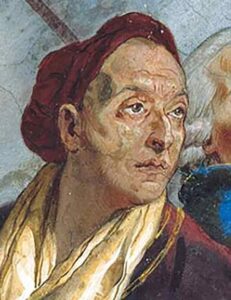Graziella Colombo

Giambattista (or Giovan Battista) Tiepolo was born in Venice in 1696 and died in Madrid in 1770. The exhibition of his work in Milan is a large and important show that will last until March 2021, unfortunately presently closed due to coronavirus infections stubbornly remaining at high levels.
In the 18th-century Venice, the cradle of many Italian artists,was no longer the powerful and rich Republic of the past, but a city in decline from a political, social and economic point of view. Yet it was still very lively culturally. It is the Venice of Canaletto, of his nephew Bernardo Bellotto and of Francesco Guardi, whose sister Tiepolo will marry. It is the Venice of the so-called vedutisti, painters who with their magnificent landscape and cityscape paintings recalled the lost grandeur of the city and were able to produce countless small pictures, which were the ‘postcards’ of their time, sold as souvenirs to tourists who came from Europe to Italy to discover and admire the countryside, her cities, monuments and artworks.
A precocious talent, Tiepolo fits into this artistic world. He developed a painting style far from the tradition of 17th-century chiaroscuro and dark backgrounds, and was full, instead, of colours and iridescent shades, of light, of fantasy, of rich environments that represented historical and mythological events and figures, sacred scenes, allegories of vices and virtues.
Having quickly become famous and sought after by noble families and European courts, Tiepolo worked extensively in his city, Venice, in Northern Italy and in Milan. The starting point of his work were the small oil paintings, or ‘sketches’ (small works of art), some of which are included in this exhibition, which he then used to create the great compositions that would become characteristic of his style: the frescoes and paintings for the walls and ceilings of the great halls in the palaces of the nobility and clergy, created to suit the taste of the patrons. A work that might at first glance seem superficial would then reveal the artist’s theatrical and scenographic talent for making stories, as well as his pictorial ability. An example is the sumptuous painting Cleopatra’s Banquet, now preserved in the National Gallery in Melbourne, which clearly evokes the art of Veronese and Palladio, from whom Tiepolo often drew inspiration. His paintings, his frescoes and the stories are revealed and easily digested as you walk along the walls of the large rooms or while, with your nose up, you observe the large painted ceilings. This is the only way to admire the vivacity of the colours, the vital energy of the artist and his frequent use of trompe l’oeil to attract and involve the viewer.
Giambattista Tiepolo was a tireless painter with many commissions. Thanks to his flourishing and well-equipped workshop and many collaborators (including two of his nine sons, Lorenzo and Giandomenico, who would also become important painters) he was much in demand. A versatile artist, he also created portraits, altarpieces and sacred compositions for churches, especially in Venice. In Milan some of his frescoes in the noble palaces were unfortunately lost during World War 2 bombings, but others remain such as in Palazzo Clerici, a noble ancient residence, where the vault of the gallery hall shines with light and colour with the running of the Sun chariot, between white and pink clouds, mythological characters and allegories of the then known continents. Some works are also kept in the Poldi-Pezzoli Museum, one of the most interesting and richest museums in Milan.
Tiepolo was also popular in the rest of Europe, and in 1752 he went to Wurzburg, Germany, to decorate the Rococo-style royal hall and most importantly to execute his most spectacular work: to paint in fresco the vast surface of the ceiling above the entrance and the main staircase of what was then the residence of the Prince Bishop the triumph of the god Apollo, surrounded here again by his interpretation of the four continents in a riot of animals, plants, historical and mythological figures. Truly a marvel.

Called by Charles III to Madrid, Tiepolo went on to decorate some rooms of the Royal Palace. And it was in Madrid that he died in 1770. By now the art world was changing, with the rise of the Enlightenment and Neoclassicism, of sober and rigorous forms, of the scientific method, ordered and precise, and of the cataloging of the world of nature in such works as Diderot’s Encyclopédie. Tiepolo remained faithful to himself, to his luminous creativity, to his pictorial ‘disorder’. This was his greatness and perhaps his limit. In any case, he tiptoed off exactly 250 years ago.
Volume 35 no 3 January – February 2021
